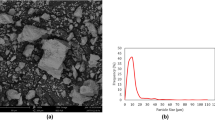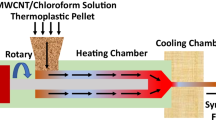Abstract
Short carbon fiber (SCF) reinforced polylactic acid (PLA) composites were fabricated by extrusion printing, and the effects of process parameters and surface treatments on the mechanical properties of composites were studied. Based on the rheological properties of composites and the extrusion process simulation, pure PLA specimens and PLA/SCF specimens were manufactured under different printing parameters. Three kinds of surface treatment were adopted to improve the mechanical properties. The experimental results show that SCF can effectively improve the tensile strength and bending strength, but the compressive strength decreased. The specimen had the best mechanical properties when the layer height was 0.1 mm and the nozzle diameter was 0.6 mm. The mechanical properties can be further improved by coupling agent coating method, and the compressive strength was even higher than that of pure PLA specimen. The research in this paper can provide a reference for the fabrication of thermoplastic composites with excellent mechanical properties by extrusion printing.
Similar content being viewed by others
References
K. V. Wong and A. Hernandez, A review of additive manufacturing, ISRN Mechanical Engineering (2012) 30–38.
S. Mellor, L. Hao and D. Zhang, Additive manufacturing: a framework for implementation, International J. of Production Economics, 149 (2014) 194–201.
F. Ning, W. Cong and J. Qiu, Additive manufacturing of carbon fiber reinforced thermoplastic composites using fused deposition modeling, Composites Part B, 80 (2015) 369–378.
A. S. Bala, S. B. Wahab and M. B. Ahmad, Elements and materials Improve the FDM products: a review, Advanced Engineering Forum, 16 (2016) 33–51.
F. P. W. Melchelsa, J. Feijena and D. W. Grijpma, A review on stereolithography and its applications in biomedical engineering, Biomaterials (24) (2010) 6121–6130.
P. A. Thomas, P. K. Aahlada and N. S. Kiran, A review on transition in the manufacturing of mechanical components from conventional techniques to rapid casting using rapid prototy**, Materials Today: Proceedings, 5(5) (2018) 11990–12002.
E. O. Olakanmi, R. F. Cochrane and K. W. Dalgarno, A review on selective laser sintering/melting (SLS/SLM) of aluminium alloy powders: processing, microstructure, and properties, Progress in Materials Science, 74 (2015) 401–477.
M. Dawoud, I. Taha and S. J. Ebeid, Mechanical behaviour of ABS: an experimental study using FDM and injection moulding techniques, J. of Manufacturing Processes, 21(1) (2016) 39–45.
V. Chandran, J. Kalman and K. Fayazbakhsh, A comparative study of the tensile properties of compression molded and 3D printed PLA specimens in dry and water saturated conditions, Journal of Mechanical Science and Technology, 35(5) (2021) 1977–1985.
K. M. M. Billah, F. A. R. Lorenzanaa and N. L. Martinez, Thermomechanical characterization of short carbon fiber and short glass fiber-reinforced ABS used in large format additive manufacturing, Additive Manufacturing, 35 (2020) 101299.
G. Sodeifian, S. Ghaseminejad and A. A. Yousefi, Preparation of polypropylene/short glass fiber composite as fused deposition modeling (FDM) filament, Results in Physics, 12 (2019) 205–222.
V. C. Gavali, P. R. Kubade and H. B. Kulkarni, Property enhancement of carbon fiber reinforced polymer composites prepared by fused deposition modeling, Materials Today: Proceedings, 23 (2020) 221–229.
S. Kain, J. V. Ecker and A. Haider, Effects of the infill pattern on mechanical properties of fused layer modeling (FLM) 3D printed wood/polylactic acid (PLA) composites, European J. of Wood and Wood Products, 78(1) (2020) 65–74.
J. Lu, L. Xu and J. Hu, Micromechanical analysis of the tensile deformation behavior for 3D printed unidirectional continuous fiber reinforced thermos-plastic composites, Journal of Mechanical Science and Technology, 34(12) (2020) 5085–5092.
Z. Hou, X. Tian and J. Zhang, Design and 3D printing of continuous fiber reinforced heterogeneous composites, Composite Structures, 237 (2020) 111945.
M. Heidari-Rarani, M. Rafiee-Afarani and A. M. Zahedi, Mechanical characterization of FDM 3D printing of continuous carbon fiber reinforced PLA composites, Composites, 175 (2019) 107147.
X. Tian, T. Liu and C. Yang, Interface and performance of 3D printed continuous carbon fiber reinforced PLA composites, Composites Part A, 88 (2016) 198–205.
F. Wang, J. Zheng and G. Wang, A novel printing strategy in additive manufacturing of continuous carbon fiber reinforced plastic composites, Manufacturing Letters, 27 (2021) 72–77.
X. Tian, T. Liu and Q. Wang, Recycling and remanufacturing of 3D printed continuous carbon fiber reinforced PLA composites, J. of Cleaner Production, 142 (2017) 1609–1618.
D. Yang, H. Zhang and J. Wu, Fibre flow and void formation in 3D printing of short-fibre reinforced thermoplastic composites: an experimental benchmark exercise, Additive Manufacturing, 37 (2021) 101686.
Y. Chen and L. Ye, Topological design for 3D-printing of carbon fiber reinforced composite structural parts, Composite Science and Technology, 204 (2021) 108644.
N. Maqsood and M. Rimaauskas, Characterization of carbon fiber reinforced PLA composites manufactured by fused deposition modeling, Composites Part C, 4 (2021) 100112.
M. A. Kumar, M. S. Khan and S. B. Mishra, Effect of fused deposition machine parameters on tensile strength of printed carbon fiber reinforced PLA thermoplastics, Materials Today: Proceedings, 27 (2020) 1505–1510.
R. L. Ferreira, I. C. Amatte and T. A. Dutra, Experimental characterization and micrography of 3D printed PLA and PLA reinforced with short carbon fibers, Composites Part B: Engineering, 124 (2017) 88–100.
P. Sharma, A. K. Dhanopia and D. Joshi, An experimental study on carbon fiber thickness and layer thickness of depositing material in fused deposition modeling, Materials Today: Proceedings, 44(6) (2021) 4479–4484.
V. D. P. Rao, P. Rajiv and V. N. Geethik, Effect of fused deposition modelling (FDM) process parameters on tensile strength of carbon fibre PLA, Materials Today: Proceedings, 18 (2019) 2012–2018.
E. A. Papon and A. Haque, Fracture toughness of additively manufactured carbon fiber reinforced composites, Additive Manufacturing, 26 (2019) 41–52.
A. Nasirov, A. Gupta and S. Hasanov, Three-scale asymptotic homogenization of short fiber reinforced additively manufactured polymer composites, Composites Part B, 202 (2020) 108269.
V. C. Gavali, P. R. Kubade and H. B. Kulkarni, Mechanical and thermo-mechanical properties of carbon fiber reinforced thermoplastic composite fabricated using fused deposition modeling method, Materials Today: Proceedings, 22 (2020) 1786–1795.
M. Botana-Galvın, G. Blanco and L. Gonzalez-Rovira, Adhesive behaviour of carbon fibre reinforced plastic panels manufactured using woven and unidirectional tape after ultraviolet laser surface treatment, J. of Composite Materials, 52 (2017) 853–865.
B.-G. Cho, S.-H. Hwang and M. Park, The effects of plasma surface treatment on the mechanical properties of polycarbonate/carbon nanotube/carbon fiber composites, Composites Part B, 160 (2019) 436–445.
S. Corujeira-Gallo and H. Dong, Effect of microstructure on the plasma surface treatment of carbon fibres, J. of Composite Materials, 51 (2016) 3239–3256.
H. Yılmaz, Y. Imai and K. Nagata, Localized thermal analysis of carbon fiber reinforced polypropylene composites, Polymer Composites, 33(10) (2012) 1764–1769.
K. Hamdi, Z. Aboura, W. Harizi and K. Khellil, Improvement of the electrical conductivity of carbon fiber reinforced polymer by incorporation of nanofillers and the resulting thermal and mechanical behavior, J. of Composite Materials, 52(11) (2018) 1495–1503.
S. Bhandari, R. A. Lopez-Anido and D. J. Gardner, Enhancing the interlayer tensile strength of 3D printed short carbon fiber reinforced PETG and PLA composites via annealing, Additive Manufacturing, 30 (2019) 100922.
M. Pizzorni, A. Parmiggiani and M. Prato, Adhesive bonding of a mixed short and continuous carbon-fiber-reinforced nylon-6 composite made via fused filament fabrication, International J. of Adhesion and Adhesives, 107 (2021) 102856.
V. H. Martínez-Landeros, S. Y. Vargas-Islas and C. E. Cruz-González, Studies on the influence of surface treatment type, in the effectiveness of structural adhesive bonding, for carbon fiber reinforced composites, J. of Manufacturing Processes, 39 (2019) 160–166.
Acknowledgments
This work was supported by the Natural Science Foundation of Zhejiang Province (LY20E050003).
Author information
Authors and Affiliations
Corresponding author
Additional information
Zhiyong Ma is an Associate Professor of the School of Engineering, Huzhou University, Huzhou, China. He received his Ph.D. in Mechanical Engineering from Zhejiang University. His research interests include bioprinting, additive manufacturing and mechanical design.
Rights and permissions
About this article
Cite this article
Ma, Z., Qian, Z. & Cai, J. Effects of manufacturing process and surface treatments on mechanical properties of PLA/SCF composites using extrusion printing. J Mech Sci Technol 36, 2355–2367 (2022). https://doi.org/10.1007/s12206-022-0417-y
Received:
Revised:
Accepted:
Published:
Issue Date:
DOI: https://doi.org/10.1007/s12206-022-0417-y




